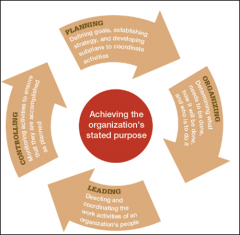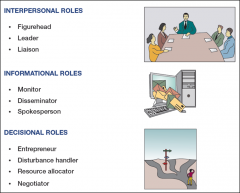![]()
![]()
![]()
Use LEFT and RIGHT arrow keys to navigate between flashcards;
Use UP and DOWN arrow keys to flip the card;
H to show hint;
A reads text to speech;
19 Cards in this Set
- Front
- Back
|
Three characteristicsthat identify an organization are its:
|
1. Goals
2. People, and 3. Structure |
|
|
Examples oforganizations include:
|
•Your neighborhoodconvenience store •The Dallas Cowboysfootball team •Fraternities andsororities •The Cleveland Clinic,and •Global companies suchas Nokia |
|
|
Thethree common characteristics that organizations share:
|
1. Goals, which express the different purpose ofa particular organization
2. People, who make decisions and engage in workactivities to reach the organization’s goals, and 3. A deliberate structure, defines and limitsits members’ behavior. |
|
|
HowAre Managers Different from Nonmanagerial Employees? NonmanagerialEmployees |
•Work directly on tasks
•Not responsible for overseeing others’ work |
|
|
HowAre Managers Different from Non-managerial Employees?
Managers |
•Direct and oversee the activities of others
•May have work duties not related to overseeing others. |
|
|
Managers are usually classified as:
|

top, middle, first-line, or team leaders.
|
|
|
What Titles Do Managers Have?
|
TopManagers:
Make decisions about the direction of an organization MiddleManagers: Manage other managers First-lineManagers: Direct non-managerial employees TeamLeaders: Manage activities ofa work team |
|
|
Top managers
|
who make decisions about the direction of the organization and establishes policies and philosophies that affect all organizational members.
Titles include: president, vice president, chancellor, managing director, or chief executive officer. |
|
|
Middle managers
|
They often manage other managers and sometimes nonmanagerial employees, and are responsible for translating the goals set by top managers into specific detailed tasks that lower-level managers oversee.
Titles include: agency head, unit chief, division manager, or project leader. |
|
|
First-line managers
|
are responsible for directing the day-to-day activities of nonmanagerial employees.
Titles include: supervisor, shift manager, or unit coordinator. |
|
|
What Is Management?
|
The process of getting things done effectively and efficiently, with and through people.
Effectiveness: Doing the right things Efficiency: Doing things right |
|
|
The most important role of a small business manager is:
|
spokesperson, performing externally in meeting with customers, arranging financing with bankers, searching for new opportunities, and stimulating change.
|
|
|
The actions of manager in a large organization:
|
are directed internally, deciding which organizational units get which and how much of the available resources..
|
|
|
Four Functions Approach:
|

•Planning
•Organizing •Leading •Controlling |
|
|
Planning includes:
|
includesdefining goals,establishing strategy, and developing plans to coordinate activities.
|
|
|
Organizing includes:
|
determining which tasks need to be done and by whom, how tasks are to be grouped, who reports to whom, and who will make decisions.
|
|
|
Leading includes:
|
motivating employees, selecting the most effective communication channel, and resolving conflicts.
|
|
|
Controlling includes:
|
monitoring performance, comparing it with goals, and correcting any significant deviations.
|
|
|
ManagementRoles Approach:
|

1. Interpersonal relationships: figurehead, leader,and liaison. 2. Informational transfer: monitor,disseminator, and spokesperson; 3. Decision-making: entrepreneur,disturbance handler, resource , allocator and negotiator." |

